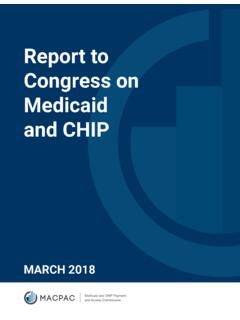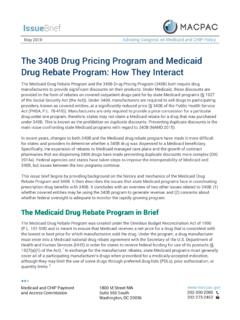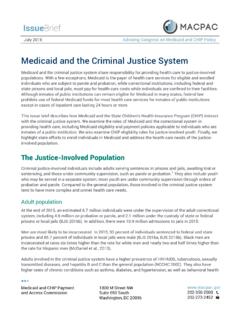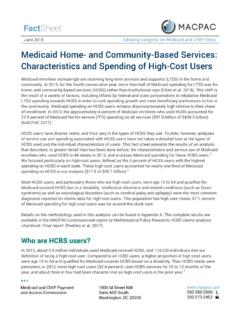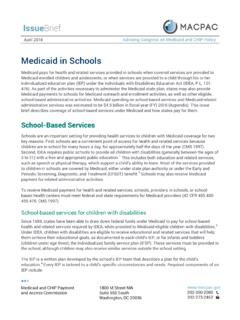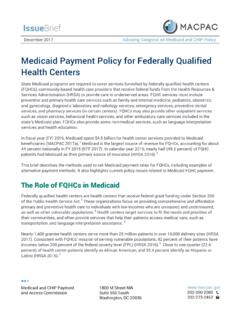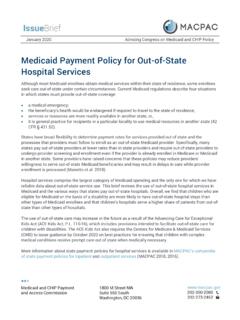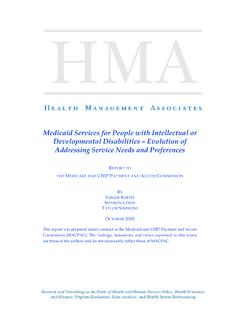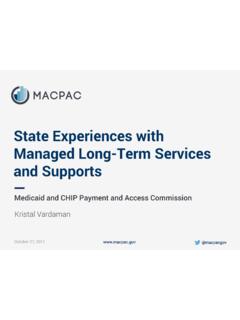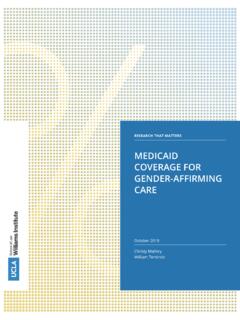Transcription of Medicaid Coverage of Adult Dental Services - MACPAC
1 January 2021 Advising Congress on Medicaid and CHIP Policy Medicaid Coverage of Adult Dental Services While Medicaid programs are required to cover Dental Services for children and youth under age 21, they are not required to do so for adults. Poor oral health is widespread among adults in the United States and especially affects those with low incomes. Individuals with a range of chronic conditions are more susceptible to oral disease, which can exacerbate chronic disease symptoms. Poor oral health can limit communication, social interaction, and employability. This issue brief examines Dental benefits for adults enrolled in Medicaid . We begin by summarizing findings from the Compendium: States' Medicaid Fee-for-Service Adult Dental Services Coverage Policies, then describe some of the changes states have made in the last few years ( MACPAC 2021). The information in this brief reflects state policies and plans as of March 2020.
2 Past experience shows that states often reduce or eliminate these benefits when there is a state budget shortfall (Lee et al. 2012, Gehshan et al. 2001). We expect that states may revise their Coverage and payment policies for Adult Dental Services in 2021 in response to the economic downturn. Overview Adult Dental benefits vary widely across Our analysis found the following: Three states provide no Adult Dental benefit, and nine states cover emergency Services only. States define emergency Services differently, although most include emergency treatment for pain and infection. Thirty-two states cover preventive Services such as cleanings and fluoride application. Restorative Services such as fillings, crowns, and root canals, are covered by 32 states. Thirty-one states cover periodontal Services , which include scaling and root planing (cleaning below the gum line).
3 Thirty-one states cover partial or full dentures. Forty-two states cover oral surgery, such as emergency extractions, six of which only cover surgery for emergent cases. Orthodontia, which may include braces, retainers, and headgear, is covered for the general Adult population by three states. 2 State policies also vary based on their definitions of the amount, duration, and scope of covered Services . About one-third (13 states) impose annual dollar and service limits. Some states have different Medicaid Dental Coverage policies for certain populations, such as allowing comprehensive care or more frequent Services for pregnant women only. Pregnant women in 11 states have expanded Medicaid Dental Coverage , 4 states have unique policies for older adults (generally, over 64 years old), and 16 states have policies for disabled Regardless of state plan Coverage , Medicaid beneficiaries enrolled in managed care may receive additional Dental benefits through their plan ( MACPAC 2020).
4 This is because Medicaid managed care organizations (MCOs) may apply savings realized through efficient management to the provision of additional benefits, for instance, Dental Coverage for adults that goes beyond state requirements (Schneider and Garfield 2002). As of July 2018, 37 states reported that MCOs in their state offered such additional Services , with enhanced Dental Services being the most common additional Services reported (Gifford et al. 2018). For example, Florida has historically offered fee-for-service Coverage of emergency-only Dental benefits to adults. Most Florida Medicaid beneficiaries, however, are enrolled in the Statewide Medicaid Managed Care (SMMC) program. Each plan participating in the Dental component of the program provides an array of added Dental benefits to all Adult enrollees, including diagnostic, preventive, and periodontal Services , and other benefits specifically targeted for pregnant women.
5 Similarly, while Hawaii eliminated all non-emergency Dental benefits for Adult fee-for-service enrollees in 2008, in 2019, two MCOs began offering limited preventive Dental health Services on a trial basis to Adult enrollees. Coverage includes an annual exam, fluoride treatment, bi-annual cleanings, one set of X-rays per year, and non-emergency tooth extraction or filling. Coverage Policy Changes As noted above, states often reduce or eliminate optional Dental benefits when there are budget shortfalls, and then restore or add benefits when state revenues rebound. In comparing results from a prior MACPAC review of Adult Dental Coverage policies in 2015 and the 2020 compendium, many changes reflect budget-driven adjustments. Below we provide examples of changes in state Adult Dental Coverage policies in recent years. We expect that states will continue to adjust their Coverage policies as budget circumstances allow.
6 Coverage changes for the entire Adult population California eliminated Coverage of non-emergency Dental Services for adults in 2009 (CA DHCS 2019). As the state s fiscal outlook improved, benefits were restored in two phases. First, a limited benefit was restored in 2014, which included preventive and restorative care and full dentures. Then in 2018, periodontal treatment and endodontic treatments as well as partial dentures were restored. Delaware has historically been one of a few states that has not provided any Dental Coverage for adults. Under legislation signed in 2019, the state established a $1,000 per member per year Dental 3 benefit (an additional $1,500 may be authorized on an emergency basis), with a $3 co-payment. The new benefit is scheduled to take effect on October 1, 2020 and will be available to all adults. Illinois reduced Medicaid Adult Dental Services to emergency-only Services in 2012 as part of a package of $ billion in Medicaid budget reductions (IL HFS 2012).
7 Limited Coverage was restored for pregnant women shortly thereafter. In 2014, restorative Services , endodontic treatments, dentures, and oral surgery Services were restored to all Adult beneficiaries. In 2018, preventive Services were added to the Adult benefit package for the first time. When Kansas transitioned to managed care in 2013, MCOs were only required to provide limited Dental Services to its Adult members. New contracts that went into effect in 2019 specified that plans are required to provide, at a minimum, preventive Dental care for all Adult enrollees. In 2005, Missouri cut back Coverage of Dental Services to trauma of the mouth, jaw, or teeth as the result of injury or medical condition for the majority of Adult enrollees (MDSS 2016). More extensive Coverage was maintained for those who were pregnant, blind, or in nursing facilities. In 2016, diagnostic, preventive, and restorative Services , as well as periodontal treatment, oral surgery, extractions, pain evaluation and relief, infection control, and general anesthesia were restored for all adults.
8 Other Coverage changes A number of states have restored or implemented new benefits for specific populations such as pregnant women, those over the age of 65, and individuals with disabilities. Some states initially implemented population-specific benefit increases, and later increased Services for the entire Adult population. In Arizona, elderly adults and those with physical and developmental disabilities can access up to $2,000 annually for Dental care. The state also restored an annual Dental benefit in 2018 allowing emergency Dental care and extractions for all Medicaid -enrolled adults up to $1,000. Idaho limited Dental benefits for adults age 21 and older to emergency-only Services in 2011 due to the economic downturn. Comprehensive Dental benefits for adults with disabilities and other special health care needs were restored in 2014. In 2018, a limited and prevention-focused benefit was restored to all non-disabled adults.
9 Maryland has historically offered no Dental benefit for most Adult enrollees. Pregnant women and individuals enrolled in the Rare and Expensive Case Management Program are covered for a wider range of Services . In 2017, the Centers for Medicare & Medicaid Services (CMS) approved Maryland s HealthyChoice waiver renewal allowing former foster care youth up to age 26 to receive full Dental benefits. In 2019, the state launched the Medicaid Adult Dental waiver program, providing Coverage of diagnostic, preventive and basic restorative Dental Services , as well as extractions, to adults age 21 to 64 who are dually eligible for Medicaid and Medicare. Services are limited by an annual cap of $800 (and $1,600 over the first 18 months through the end of 2020). 4 Utah eliminated a broad array of Dental Services in 2009, leaving most adults with an emergency-onlydental benefit. Over the past several years, the state has worked to expand Coverage for specificpopulations.
10 In 2017, legislation was signed developing a partnership between Medicaid and theUniversity of Utah School of Dentistry to provide Dental Services to blind and disabled Adult T he state also expanded its Medicaid program by creating the Targeted Adult Medicaid (TAM) program for adults without dependent children, earning up to 5 percent of the federal povertylevel (FPL) who are chronically homeless; involved in the justice system; or needing substance abuseor mental health Dental Services for TAM members who are actively receiving treatment ina substance abuse program are provided through the University of Utah School of Dentistry. In 2019,legislation was signed to expand Dental Coverage for adults age 65 and older through the university orits contracted Dental Virginia has long offered an emergency-only benefit to adults enrolled in its Medicaid program. In 2015the state extended comprehensive Dental benefits to approximately 45,000 pregnant women enrolledin Medicaid and CHIP (VA DMAS 2015).

